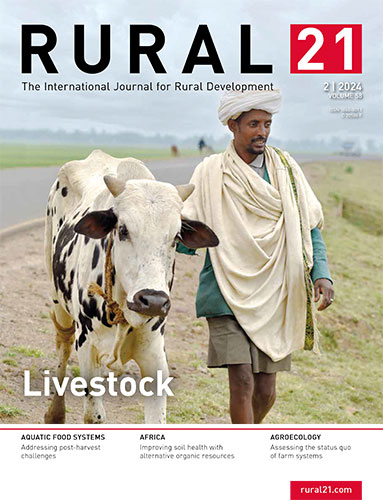Vol. 58 No. 2/2024
Livestock
Regarding the transformation of our agricultural and food systems, hardly any sector has been as controversially discussed as livestock farming. In the Global North, quite a few people would like to see animal products entirely deleted from the human diet – because this could reduce the emission of harmful greenhouse gases; because valuable natural resources such as land and water could be used more efficiently; because deforestation to create pastureland could be stemmed, which would protect biodiversity; and because, in many cases, they cannot reconcile animal husbandry with their animal welfare aspirations. Not to mention the rapid growth of malnutrition and nutrition-related illnesses through excessive consumption of animal-sourced food and health risks such as the transmittance of zoonotic diseases.
However, a world without animal agriculture is simply not realistic. The issue here is not just that of producing food such as milk, eggs and meat, which represent an important source of proteins and micronutrients for many people, or of using draught animals for land cultivation. For women in particular, keeping small livestock is often the only option to earn their own income, and is hence key to economic and social empowerment. Animals can serve as forms of saving, insurance and social security. And they are an integral element of the urgently needed agro-ecological transformation, which is also based on the principles of the circular economy and (nutrient) recycling.
By declaring 2024 the International Year of Camelids, the United Nations has been highlighting the importance of these animals – and hence also the importance of the pastoralist way of living – for food security and ecosystem functions. Knowing fully well that sustainable solutions for tomorrow’s livestock systems always need a multi-faceted and context-specific lens, our authors ultimately back livestock farming too.
Click here if you are interested to subscribe
Download edition 2024/02 Focus: "Livestock"
Focus
- Livestock and sustainable food systems – a complex relationship
- A sector in transition
- Learning from pastoralists
- Pastures benefit cattle welfare and product quality
- World map of pastoralists
- Livestock insurance – promise of a resilience-building tool for pastoral communities
- Unveiling opportunities and reducing climate vulnerability in the camelid value chain in the Andean Region
- Unleashing the potential of women livestock keepers
- Strengthening Uganda’s beef industry through innovation
- Farmer-herder conflicts in Africa – dynamics and potential solutions
- Effects of sedentarisation policies
- The untapped potential of protein diversification




